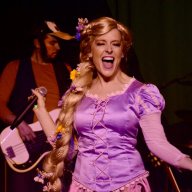By Kent Mancusco
The rather naughty title, “Once Upon a Mattress,” is a clever play on words referring to the famed fairy-tale test of a ”genuine” princess. Can she feel a pea placed beneath a stack of 20 mattresses? More than just a fractured fairy tale, however, this delightful musical by Mary Rodgers, daughter of the famed Richard Rodgers, is filled with characters that display a range of human foibles: an overprotective mother and castrating wife, a put-upon husband, and an overripe son, Prince Dauntless, eager for a romp in the hay, to name a few.
Parkside Players in Forest Hills took on this challenging musical as their May 2002 production. The play relies heavily on a super-human leading lady, Princess Winifred, the role made famous by a young Carol Burnett and recently re-created by Sarah Jessica Parker. She sings four songs that require comedic acting and dancing, and must radiate enough charm to win the heart of the prince and incur the jealous wrath of her would-be mother-in-law. The play also demands the ensemble to be filled with vivid personalities, since they all have lines to deliver — a mean trick these days when it’s tough enough just to assemble a chorus at all.
Happily, Parkside succeeded largely on both accounts. At the core of its production was the considerable talent of Linda May as Winifred. May was a delight to the eye and ear, an inexhaustible font of energy and humor. She had the audience rolling with laughter as she endured her ”test” of trying to sleep on the stack of mattresses. No mere caricature clown was she, but rather a fully developed human being, with warmth and sincerity to spare.
May’s brio and stage presence were matched by Liz Shawkat’s Queen Aggravain, a true comic villainess. She used her rich contralto voice to delightfully fiendish effect and displayed fine comic timing. Director W. Gordon Innes is to be credited with entrusting the ensemble of ladies-in-waiting to mostly veteran actresses. Rosemary Innes, Anahid Andrias, Alison Schwab, and Krista Beicht took the time to develop distinct personalities, packaged with grace, poise, and smiles. Miss Schwab doubled as the warbling nightingale with great effect. Kudos to all.
The lead lady-in-waiting, Lady Larkin, is at the dramatic core of the play. As a result of a momentary indiscretion with her leading man, Sir Harry, she finds herself pregnant — and unwed. But like all the ladies-in-waiting, she cannot be married until Prince Dauntless first finds and marries a genuine princess. Dolores Voyer’s Lady Larkin displayed a lovely soprano voice and dreamy eyes, but did little to convey the urgency of her situation. She and Sir Harry developed no visible chemistry and their romantic scenes were flat.
On the male side, Ray Bonett’s King was a clear standout. Muted by a curse until the very end of the play, his character used vivid pantomime to speak and to sing. He did all very well indeed without missing a word. At his side was the excellent Jester of David Arzberger. Reminding one of Marty Feldman, Arzberger used serpentine moves and expressive faces to recreate a jester’s eerie world. His dance moves in his solo number were superb, but the music director should have had enough sense to raise the key to suit his tenor voice.
Apart from two exceptional performances, the other men’s contributions were grounded in amateur land. With a beautifully sung opening number to his credit, Marc Strauss fell into cartoon-like posturing with little expression, a far cry from a minstrel’s magical art of story telling. Kevin Schwab’s Prince Dauntless had enough nervous energy to light up a city, rather like an R2-D2 on overdrive. He too sang well, but with his gimmicky gesturing and juvenile appearance, he never focused into a believable love match for Princess Winifred. I give that marriage six months.
David Funke as Sir Harry would be advised not to accept singing roles that lie above his range rather than to ask an audience to endure broken notes whenever he approached the top of the staff. The director would be advised to require a romantic lead to do more than deliver lines as if he were reading cue cards. As the Wizard, Gerry Walter should have spent less time with his inappropriately ghoulish facial make-up and more time developing his character as a comic villain to match Queen Aggravain.
However, all these performers, as well as the jolly male ensemble (Jim Azelvandre, Rob Gold, and Roger McIlvaine), ingenuous princess #12 (Catherine McIlvaine), and flirtatious Mabelle (Nicole Levinson) deserve credit for knowing all their lines, entrances, and dance moves without skipping a beat, quite a feat in as difficult a show as this one.
Director Innes paced the show well by putting his cast into high gear. He also developed a clever revolving centerpiece with mattresses on one side and the thrones on the other, so that scenes were changed in a snap. On the other hand, he might have spent more time helping the performers develop their characters. Music director Kevin Ryan produced a group of well-rehearsed singers and instrumentalists. The choreography of Alexis Tandit was clever, stylish, and sprightly. Her main production number, “The Spanish Panic,” came off admirably.
The Parkside Players, a true staple in the theater circuit of Queens, is located at Grace Lutheran Church, 103-15 Union Turnpike, in Forest Hills. Call 497-4922 for reservations. Visit them online at https://come.to/parkside Be on the lookout for their Fall 2002 production, due in November.
























